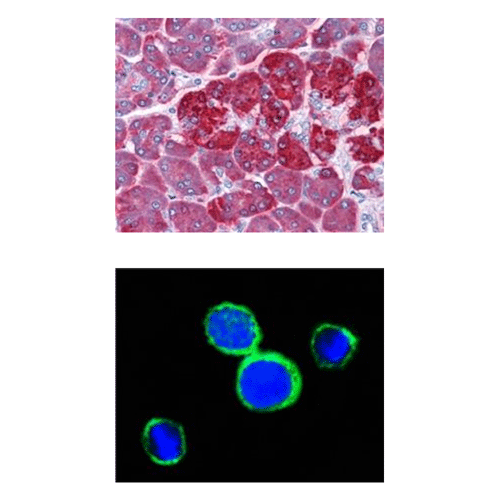Anti-REG1A: Mouse REG1A Antibody |
 |
ACKGROUND Regenerating gene (Reg), which is expressed in regenerating pancreatic islet, was first identified in the screening of regenerating islet-derived cDNA library taken from 90% depancreatized rat. Reg and Reg-related genes constitute a family within the superfamily of calcium-dependent lectin (C-type lectin). The C-type lectins are involved in several complex events, such as human malignancy and other diseases. The Reg gene family consists of a group of acute phase reactants, lectins, antiapoptotic factors, or growth factors for pancreatic islet cells, neural cells, and epithelial cells in the digestive system. Until now, 17 members of the Reg family have been identified and classified into four classes (Reg I-IV), based on the primary structures of the encoded proteins. Reg I proteins have two members of human REG I gene, REG1A and REG1B. Regenerating gene I alpha (REG1A) encodes a 166-amino-acid protein with a 22-amino-acid signal sequence. The REG1A protein is identical to the pancreatic thread protein, pancreatic stone protein, or protein X, and is highly represented in human pancreatic secretion. REG1A protein is a known growth factor affecting pancreatic islet beta cells and is secreted by the exocrine pancreas. It is associated with islet cell regeneration and diabetogenesis and may be involved in pancreatic lithogenesis. The REG1B gene codes for a transcript with 87% homology to the REG1A transcript. The secretory Reg I protein is synthesized in the regenerating beta cells, and through the Reg I receptor, stimulates the proliferation of pancreatic beta cells, leading to an increase in the beta cells mass in 90% depancreatized rats and nonobese diabetic mice and hence amelioration of experimental diabetes. Reg family members REG1B, REGL, PAP and REG1A are tandemly clustered on chromosome 2p12 and may have arisen from the same ancestral gene by gene duplication.1
In addition, REG1A expression also has been observed in various tumors. EXTL3 encodes the receptor to which the REG1A protein binds. Both REG1A and EXTL3, are overexpressed in colorectal tumors of patients who are at high risk of recurrence. It was demonstrated that REG1A is a molecular marker of prognostic value and is associated with peritoneal carcinomatosis in colorectal cancer (CRC).2 Moreover high levels of REG1A expression by tumor cells are an independent predictor of a poor prognosis in patients with non-small cell lung cancer (NSCLC).3
In addition, REG1A expression also has been observed in various tumors. EXTL3 encodes the receptor to which the REG1A protein binds. Both REG1A and EXTL3, are overexpressed in colorectal tumors of patients who are at high risk of recurrence. It was demonstrated that REG1A is a molecular marker of prognostic value and is associated with peritoneal carcinomatosis in colorectal cancer (CRC).2 Moreover high levels of REG1A expression by tumor cells are an independent predictor of a poor prognosis in patients with non-small cell lung cancer (NSCLC).3
REFERENCES
1. Yuan, R.H. et al: Clin. Cancer Res. 11:2568-75, 2005
2. Astrosini, C. et al : Int. J. Cancer 123:409-13, 2008
3. Minamiya, Y. et al: Lung Cancer 60:98-104, 2008
2. Astrosini, C. et al : Int. J. Cancer 123:409-13, 2008
3. Minamiya, Y. et al: Lung Cancer 60:98-104, 2008
Products are for research use only. They are not intended for human, animal, or diagnostic applications.
Параметры
Cat.No.: | CP10353 |
Antigen: | Raised against recombinant human REG1A fragments expressed in E. coli. |
Isotype: | Mouse IgG1 |
Species & predicted species cross- reactivity ( ): | Human, Mouse, Rat |
Applications & Suggested starting dilutions:* | WB n/d IP n/d IHC 1:50 - 1:200 ICC 1:50 - 1:200 FACS n/d |
Predicted Molecular Weight of protein: | 19 kDa |
Specificity/Sensitivity: | Detects endogenous REG1A proteins without cross-reactivity with other family members. |
Storage: | Store at -20°C, 4°C for frequent use. Avoid repeated freeze-thaw cycles. |
*Optimal working dilutions must be determined by end user.
Документы
Информация представлена исключительно в ознакомительных целях и ни при каких условиях не является публичной офертой








